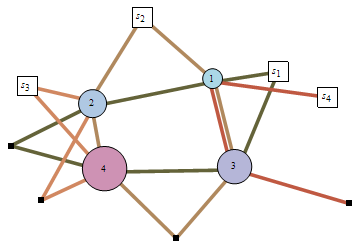
A network with four shared resources and four traffic sources, three of
which have a choice of path. The resources have capacities
C1=1,
C2=2,
C3=3,
C4=5.
Each resource is colour-coded according
to its resource poolability Ψ:
- If resource 1 experiences a traffic surge then traffic from sources s1 & s2 can easily be rerouted over other paths, which increases load on link 4, so some traffic from s3 will be rerouted as a knock-on effect. Traffic from s4 has no other paths available, but it doesn't suffer as much as it might, because s1 moves some of its traffic from resource 1 to resource 3 which has more capacity available. Mathematically, resource 1 has resource poolability Ψ1,1=0.91.
- If resource 4 experiences a traffic surge then traffic from sources s1 & s2 will have to use resource 1 instead. But resource 1 has little capacity (as indicated by its small size), so congestion will increase significantly. Mathematically, resource 4 has resource poolability Ψ4,4=0.54.